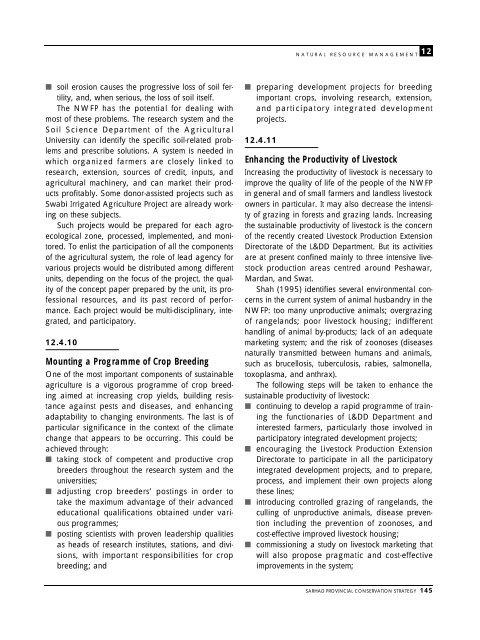Sarhad Provincial Conservation Strategy - IUCN
Sarhad Provincial Conservation Strategy - IUCN
Sarhad Provincial Conservation Strategy - IUCN
You also want an ePaper? Increase the reach of your titles
YUMPU automatically turns print PDFs into web optimized ePapers that Google loves.
■ soil erosion causes the progressive loss of soil fertility,<br />
and, when serious, the loss of soil itself.<br />
The NWFP has the potential for dealing with<br />
most of these problems. The research system and the<br />
Soil Science Department of the Agricultural<br />
University can identify the specific soil-related problems<br />
and prescribe solutions. A system is needed in<br />
which organized farmers are closely linked to<br />
research, extension, sources of credit, inputs, and<br />
agricultural machinery, and can market their products<br />
profitably. Some donor-assisted projects such as<br />
Swabi Irrigated Agriculture Project are already working<br />
on these subjects.<br />
Such projects would be prepared for each agroecological<br />
zone, processed, implemented, and monitored.<br />
To enlist the participation of all the components<br />
of the agricultural system, the role of lead agency for<br />
various projects would be distributed among different<br />
units, depending on the focus of the project, the quality<br />
of the concept paper prepared by the unit, its professional<br />
resources, and its past record of performance.<br />
Each project would be multi-disciplinary, integrated,<br />
and participatory.<br />
1 2 . 4 . 1 0<br />
Mounting a Programme of Crop Bre e d i n g<br />
One of the most important components of sustainable<br />
agriculture is a vigorous programme of crop breeding<br />
aimed at increasing crop yields, building resistance<br />
against pests and diseases, and enhancing<br />
adaptability to changing environments. The last is of<br />
particular significance in the context of the climate<br />
change that appears to be occurring. This could be<br />
achieved through:<br />
■ taking stock of competent and productive crop<br />
breeders throughout the research system and the<br />
universities;<br />
■ adjusting crop breeders’ postings in order to<br />
take the maximum advantage of their advanced<br />
educational qualifications obtained under various<br />
programmes;<br />
■ posting scientists with proven leadership qualities<br />
as heads of research institutes, stations, and divisions,<br />
with important responsibilities for crop<br />
breeding; and<br />
N A T U R A L R E S O U R C E M A N A G E M E N T 12<br />
■ preparing development projects for breeding<br />
important crops, involving research, extension,<br />
and participatory integrated development<br />
p r o j e c t s .<br />
1 2 . 4 . 1 1<br />
Enhancing the Productivity of Livestock<br />
Increasing the productivity of livestock is necessary to<br />
improve the quality of life of the people of the NWFP<br />
in general and of small farmers and landless livestock<br />
owners in particular. It may also decrease the intensity<br />
of grazing in forests and grazing lands. Increasing<br />
the sustainable productivity of livestock is the concern<br />
of the recently created Livestock Production Extension<br />
Directorate of the L&DD Department. But its activities<br />
are at present confined mainly to three intensive livestock<br />
production areas centred around Peshawar,<br />
Mardan, and Swat.<br />
Shah (1995) identifies several environmental concerns<br />
in the current system of animal husbandry in the<br />
NWFP: too many unproductive animals; overgrazing<br />
of rangelands; poor livestock housing; indifferent<br />
handling of animal by-products; lack of an adequate<br />
marketing system; and the risk of zoonoses (diseases<br />
naturally transmitted between humans and animals,<br />
such as brucellosis, tuberculosis, rabies, salmonella,<br />
toxoplasma, and anthrax).<br />
The following steps will be taken to enhance the<br />
sustainable productivity of livestock:<br />
■ continuing to develop a rapid programme of training<br />
the functionaries of L&DD Department and<br />
interested farmers, particularly those involved in<br />
participatory integrated development projects;<br />
■ encouraging the Livestock Production Extension<br />
Directorate to participate in all the participatory<br />
integrated development projects, and to prepare,<br />
process, and implement their own projects along<br />
these lines;<br />
■ introducing controlled grazing of rangelands, the<br />
culling of unproductive animals, disease prevention<br />
including the prevention of zoonoses, and<br />
cost-effective improved livestock housing;<br />
■ commissioning a study on livestock marketing that<br />
will also propose pragmatic and cost-effective<br />
improvements in the system;<br />
SARHAD PROVINCIAL CONSERVATION STRATEGY 145

















